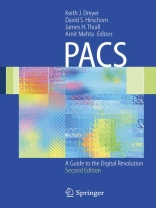PACS: A Guide to the Digital Revolution, Second Edition, fills an incredible need by explaining the technological advances associated with the transition of radiology departments to filmless environments. The editors are leaders in the field of medical imaging and they provide insight into emerging technologies for physicians, administrators, and other interested groups. Chapters address key topics in current literature with regard to the generation, transfer, interpretation, and distribution of images.
This new edition has been updated to include: 1. An overview of the latest medical imaging standards; 2. A discussion of security issues as they relate to PACS, especially regarding HIPAA; 3. An introduction to current information on PACS workstations, including the impact of new software and hardware on radiologists; 4. An updated explanation of data storage and compression that highlights how advancements are applied; 5. A section on how PACS influences research and education.
Table of Content
Administrative Issues.- to RIS and PACS.- PACS Strategic Plan and Needs Assessment.- Creating the PACS Request for Proposal and Selecting a Vendor.- Reengineering Workflow: A Focus on Personnel and Process.- Reengineering Workflow: The Radiologist’S Perspective.- Financial Modeling.- Legal Issues and Formal Policies.- Technical Issues.- Computer Fundamentals.- Digital Imaging Fundamentals.- Image Acquisition.- Image Compression.- PACS Architecture.- Networking Fundamentals.- Servers and Operating Systems.- Storage and Enterprise Archiving.- Image Displays.- Digital Mammography.- Web Distribution.- Clinical Issues.- PACS Workstation Software.- Breast Imaging, Computer-Aided Detection, and Computer-Assisted Classification.- Three-Dimensional Imaging in Radiology.- Voice Recognition.- Order Entry in Radiology.- Digital Teaching Files and Education.- Teleradiology.












